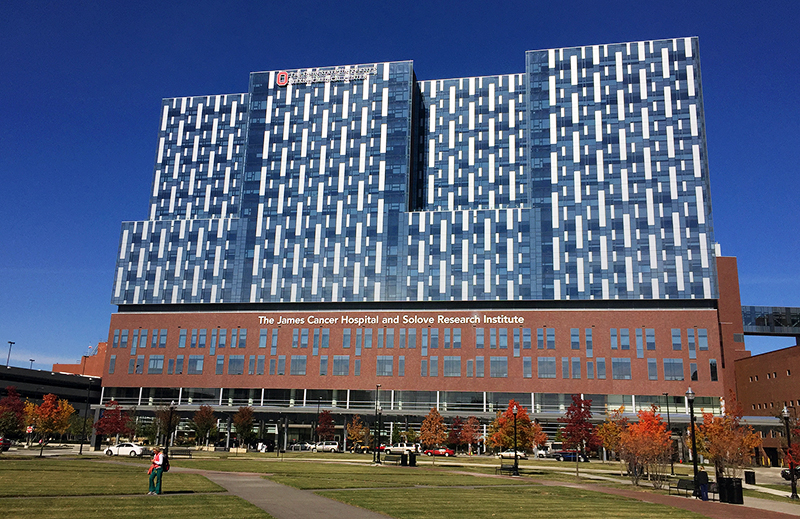
The Wexner Medical Center is located on Ohio State’s South Campus at 410 West 10th Ave. Credit: William Kosileski | Lantern Reporter.
The Wexner Medical Center at The Ohio State University has been recognized as one of the most-connected hospitals in the country in 2014, according to a recent study by U.S. News & World Report.
The U.S. News & World Report Most Connected Hospitals 2015-16 Study was published in mid-October and acknowledged OSU’s Wexner Medical Center and 158 other hospitals in the nation based on each hospital’s commitment to improve patient care through digital technology by combining the three domains of clinical connectedness, patient engagement and patient safety.
The Wexner Medical Center met the requirements to be included in the list and, according to the report, scored 62.5 out of 75 points in the 2014 survey. The medical center scored 60 out of 61 points in the 2013 version.
“I think it is more about the work we do to do all of these things, and then the recognition helps us to tell the story of what we are doing,” said Phyllis Teater, chief information officer and associate vice president of the medical center. “It does help our providers and staff to feel like people are noticing the great things that we do. It helps us to look at the criteria to help us learn and continue to improve.”
Responses were cataloged from the American Hospital Association Annual Survey Information Technology Supplements, which received responses reflecting 3,308 hospitals in 2014 with a response rate of about 60 percent, according to the report.
Each hospital initially had to be considered high-performing or nationally ranked by U.S. News & World Report’s current Best Hospitals for Complex Care, Best Hospitals for Common Care or Best Children’s Hospitals surveys to be eligible for recognition as most-connected, according to the report.
“We are the only sort of academic medical center in central Ohio. We can learn from our researchers to help us improve care,” Teater said. “We have access to all of those great minds to help us improve care for our patients.”
A hospital’s recognition was based on its domain-specific and overall scores from a set of questions in the 2013 and 2014 AHA annual surveys.
One domain in the report is patient engagement, which accounted for one-fifth of the total score in 2013 and one-tenth in 2014
Patient engagement, according to the report, is a hospital’s ability to give patients electronic access to their medical information and allow them to update or change it.
The Wexner Medical Center had a perfect score in the 2014 IT Supplement for patient engagement.
Dr. Susan Moffatt-Bruce, the chief quality and patient-safety officer, said the medical center shines in patient engagement through an online patient portal called MyChart, which allows patients to communicate with their physician, order prescription renewals and schedule appointments, among many other things, on their own time.
“We have over 130,000 patients connected to their own chart,” Moffatt-Bruce said. “If you go to the doctor and then go home after, you can get onto your own MyChart to see your results and track your progress.”
Another domain, clinical connectedness, is described in the report as electronically sharing patient information with other hospitals and health care providers. This criterion accounted for nearly half the score in 2013 and a little over 60 percent in 2014.
The Wexner Medical Center scored 36 out of 47 in this category in the 2014 AHA IT Supplement, according to the study.
Teater said the Wexner Medical Center excels in clinical connectedness by sending information and records to and from other health-care providers in Ohio and across the country.
“We communicate with providers in 48 other states,” she said, adding that the medical center also uses a “secure online portal” that allows other health-care providers to access medical information on patients that have been treated at the Wexner Medical Center.
Patient safety is the final domain and is described as a hospital’s ability to protect patients by preventing harm through “computerized means,” according to the report. This criterion counted for one-third of 2013 and one-fourth of 2014.
The medical center scored 18.5 out of 20 in this domain in the 2014 survey, showing its commitment to patient safety, Moffatt-Bruce said.
“(Patient safety) is our number one priority,” she said. “It is our No. 1 goal to make sure our patients get the safest care possible.”
One way the medical center protects its patients is through barcoding, Teater said. Each patient wears a bracelet with a barcode on it and is placed in a room that has a barcode reader in it, which a hospital employee uses to scan the patient’s bracelet to ensure that each patient is receiving proper treatment.
“(The barcode reader) verifies that it is the right medication that the doctor ordered in the right dose and right form,” Teater said.
While it excels in the three domains highlighted in the report, Teater said the medical center also takes advantage of the multiple resources and programs that OSU has on campus to improve patient care.
“We work very hard to understand how we can bring the research education and patient care mission together to improve people’s lives,” Teater said.


